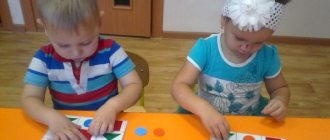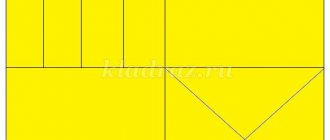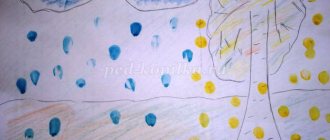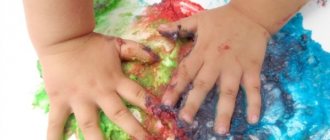Summary of an open lesson on FEMP in the first junior group “Geometric Figures”
The teacher suggests tracing a circle with your finger.
Educator: Let's look further:
- I have three tops, three corners, three sides. Who am I?
Children: Triangle.
He takes out a triangle and attaches it next to the circle: “What else did the Bunny bring us? What is the name of this figure?
The teacher invites the children to repeat the name of the figure in chorus, and for some children to show its sides and angles.
Educator: Well done! And here is another figure:
“I’m not an oval, I’m not a circle, I’m not a friend to a triangle,
This is the kind of brother I am.
And my name is...
Children: Square.
Then he takes out a square, places it next to the triangle, names the figure, shows the sides and corners of the square and asks the children: “What does a square have? How many sides does a square have? How many angles does a square have?
The teacher asks the children to circle the square and show its sides (corners).
The teacher summarizes the children's answers and actions.
part 2
. Educator: “What great fellows you all are. They correctly named all the geometric shapes that Bunny brought. I think he really enjoyed being with you, and he offers to warm up a little.
Physical school
The little gray bunny sits and wiggles his ears!
(Children squat down and use their hands to imitate how a bunny moves its ears)
Just like that, like that, and he moves his ears!
It's cold for the bunny to sit, we need to warm his little paws,
That's it, that's it, we need to warm our little paws!
(Children lightly clap palm to palm, then stand up)
It's cold for the bunny to stand, the bunny needs to jump!
Hop - hop - hop - hop, the bunny needs to jump!
(Children jump on two legs, pressing their hands to their chest)
Someone scared the bunny, the bunny jumped and ran away.
(The children scatter in all directions, and the teacher takes the fox and runs after the bunnies)
Educator: - Well done! The bunny told me that in our group there are a lot of objects that have the same shape as his gifts - a circle, a square, a triangle. And he offers to find them.
Look, under each of you there is a card with a picture of a circle, square, triangle. Take them and look at them. Then look carefully at our group and find something round, square, triangular.
(Children, in accordance with the image on the card, find the necessary objects of round, square, triangular shape.)
Educator: Well done, you also coped with this task.
Part 3.
Outdoor game "Find your house."
There is a circle, a triangle and a square on the tables. Children take one geometric figure that was under their chairs and call them the keys to the house (hoop). Children with keys go to the carpet and begin to move to the music. At the end of the melody, the teacher says that it is night and they must find their houses: those with a circle in their hands run to the circle, those with a triangle run to the triangle, those with a square run to the square. When the children take their places, the teacher asks them to justify their choice.
Summary of lessons on FEMP in the first junior group
Summary of lessons on FEMP in the first junior group
Topic: “Find your house.”
Tasks:
consolidate the ability to create a homogeneous group of objects by adding an object to an object; consolidate the ability to distinguish between the concepts “one” and “many”; develop memory and thinking; foster activity.
Progress of the lesson:
1.
Organizing time. Children enter the group. They see rings from the pyramid scattered across the floor.
Educator: “Ay-ay-ay! Who scattered the toys?"
The children discovered the horse.
Educator: “Horse, were you the one who scattered the toys around the group?”
Horse: "Yes."
Educator: “Children, is it really possible to do this?”
Children: “You can’t. No".
Educator: “Horse, what a bad thing you did. You can't throw toys around. Understood?".
Horse: "Yes."
Educator: “Since you understand that this is bad, then collect the toys, and the guys will help you. You just have to assemble the pyramid correctly: first the big rings, then the smaller ones, then the smaller ones.”
2.
Outdoor game “Assemble a pyramid.” The children began collecting rings throughout the group. The teacher holds a rod on which rings are strung. As the pyramid is collected, the teacher specifies the color and size of the ring. Children answer individually or in chorus. If one child makes a mistake, the other corrects him. Vocabulary words are being repeated and consolidated. When the pyramid is assembled, the teacher praises each child. The colors and sizes of the pyramid rings are repeated once again. The horse thanks the children for their help. The teacher invites her to play with the children.
3.
Finger gymnastics. Children sit on chairs. Finger gymnastics is carried out
I play with toys: (Hands in front of you, clench and unclench the fingers of both hands.)
I throw the ball to you, (We stretch our arms forward - “throw the ball.”)
I assemble the pyramid (we place straight hands, palms down, on top of each other several times.)
I drive the truck everywhere. (We move the slightly open hand of our right hand in front of us - “roll the car.”)
4.
Didactic game "Find your house." The teacher invites the children to play a new game “Find your house”. The teacher lays out four hoops on the floor, with one colored circle in the center of each.
The teacher explains the task: “We have a pyramid. She has a lot of colorful rings on her. What color are the rings?
Children repeat the names of the colors again.
Educator: Well done, children! You know colors well. Now we need to place these colored rings around the houses. Each color has its own house: yellow house (the teacher points to the yellow circle on the floor)
, blue house, red and green house. What color is this ring, Caroline?
Caroline: Blue.
Educator: Which house will you put it in?
Caroline: Blue.
Educator: Correct! Well done!.
This way all the rings find their homes. As the game progresses, there is an active repetition of the names and sizes of the rings. The teacher praises each child. If the baby makes a mistake, another child helps him.
5.
Summarizing. The horse, who watched the progress of the game, volunteers to help assemble the pyramid at the end of the game “Find your house.” Children monitor whether the horse collects the rings correctly. If she finds it difficult or makes a mistake, the kids help her. After the pyramid is assembled and put back in place, the horse thanks the kids for teaching it how to play correctly.
Horse: Now I know all the colors: yellow, blue, red, green. All sizes: large, small, small. Thank you guys. And now it’s time for me to go home, my mother is waiting for me. Goodbye.
Children say goodbye to the horse.
Educator: Children, did you like playing with the horse?
Children share their impressions of the game. The lesson is over.
Notes on mathematics in 1st junior group
Summary of the final lesson in the first junior group on cognitive development (FEMP) on the topic: “Funny little train”
Program content:
Consolidate knowledge of the number of objects (one-many); primary colors (red, blue, green, yellow); learn to assemble a whole from parts; ability to distinguish the size of objects (large - small). Develop fine motor skills of children's hands. Develop memory, thinking, intelligence. To foster friendly relationships between children and interest in activities.
Material:
a toy bear, chairs for children, carriages, wheels, two boxes (large and small), toys large and small.
Progress of the lesson
Educator:
Guys, we have guests today. Let's say hello to them.
Children:
Hello!
Educator:
Look who it is?
(children answer “A steam locomotive and carriages.”
Tell me how many locomotives and carriages?
( there is one locomotive, but there are many carriages).
Correct!
1. Didactic game
“One - many”
Purpose:
consolidate the ability to distinguish between the number of objects (one-many), when answering, use the words one, many.
Educator:
But you and I can’t go because our trailers don’t have wheels. Let us repair them for you.
2. Didactic game
“match by color”
Game progress:
invite the children to help the trailers find their own color. On one table there are trailers and wheels. The child needs to take one trailer, find the trailer by color (the same as the trailer), and name the color. The game continues until all the trailers have wheels.
Educator:
Well done boys.
Educator:
Now take your seats and let’s go visit the bear. Here we are. Look, the bear is sitting and crying. Let's go and ask the bear what happened.
Educator
: Children, Mishka told me in my ear that he was playing with the toys, but now he can’t put them back into the box. So that his mother does not scold him, let us help him and collect all the toys.
3. Didactic game
“Cut pictures”
Objectives: to teach how to assemble a whole from parts; develop children's thinking; To form in children ideas about the holistic image of an object, to teach them to correlate the image of the idea with the holistic image of a real object, to fold a picture cut into 4 parts. Act by applying. To cultivate in children attention, perseverance, and perseverance in completing the assigned task.
Equipment. Cut pictures from 4 parts. Items and toys that match those in the pictures.
4 .
Didactic game “more - less”
Purpose:
strengthen the ability to distinguish objects by size.
Equipment:
two boxes (large and small), toys (large and small), a toy bear.
Progress of the game.
Children need to help the bear put the toys into the box. Collect large toys in a large box, and small ones in a small one.
Educator:
Fine! Guys, the bear thanks you for your help. Look, I still have a box, the bear has prepared a sweet treat for you. It's time for us to go back to kindergarten. We take our seats and set off. - Attention attention! Next stop: Kindergarten.
Educator:
So we returned to the Kindergarten.
Tell me who we met during our journey ( children's answers
). Did you like it?
Summary of mathematics lesson in 1st junior group
Program content:
1. Learn to select objects based on color, by display and by verbal designation.
2. Develop ideas about geometric shapes.
3. To consolidate children's knowledge of colors and shapes.
4. To develop the ability to isolate and combine objects according to one (common) characteristic.
5. Develop imagination, memory, imaginative thinking.
6. Cultivate curiosity, expand the experience of orientation in the environment, enriching children with a variety of sensory impressions.
Demonstration material.
Two screens: one depicts a large house, the other a small one. Two ribbons: short - red, long - green, two toy bears, geometric shapes: circles, squares (green, blue and yellow), hoops yellow, green and blue, two cars - large and small, cubes and balls : large and small (yellow, green and blue).
Progress of the lesson:
Educator. Today we will go to visit our friends, and who you will now recognize.
Clumsy, clubfooted,
When they sleep, they suck their paws,
They eat raspberries and love honey.
What are their names? (bears).
Educator. That's right, these are bears, to get to them we will need to go along a long path. (there are two tracks on the floor: a long one - green and a short one - red).
Educator Let's go along the long path, which of the two paths is longer - red or green? (Green.) I lay out the green ribbon: one end of it is near the children’s feet, the other is near the screen with pictures of houses. Children follow the teacher along the tape and approach the screen. Educator. We walked and walked and came to the houses of our friends - the bears. Look at the houses the cubs have. Are they the same? (No, one is big, the other is small). What about the bear cubs? (one big, one small)
Educator. What house do you think big Misha lives in (in a big house). And which one does little Mishka live in (in a small house).
I place the toys next to the corresponding houses.
Educator. Our friends the bear cubs are sad today, let's find out. What's happened. Guys, they need our help. Their friend Toptyshka sent them toys, here they are, but they are all mixed up and now they don’t know where whose toys are (I show the toys: 2 cars, cubes, balls of different sizes and colors). Shall we help?
I show the toys and ask:
Educator. What is this? That's right, the ball.
How big or small is it?
What color is the little ball?
Who do you think should put it in? Big bear or little one?
Educator. You guys are great, the bears thank you for your help. And for this they want to give you their toys - geometric figures. I make riddles
I have no corners
And I look like a saucer
On the plate and on the lid,
On the ring, on the wheel.
Who am I, friends? (Circle) .
I draw a circle with my hand and invite the children to draw a circle with their hand in the air.
Every angle is straight,
All four sides
Same length.
I'm glad to introduce myself to you!
What's my name? ( Square)
I trace a square with my hand and invite the children to draw a square in the air.
Educator. Do you want to play with these figures? Game "Find the house".
In the clearing there are hoops - houses, what color are they? (blue, yellow, green). And there are circles nearby, what color are they? (blue, green, yellow). You will need to find houses for the circles by color.
While the music is playing, children take circles and find houses for them.
The game with squares is played again.
Guys, did you enjoy playing? (children share their impressions). What did you do, what did you do? (we looked for houses for figures by color, selected toys by size).
Well done boys. Now it's time for us to return to kindergarten.






